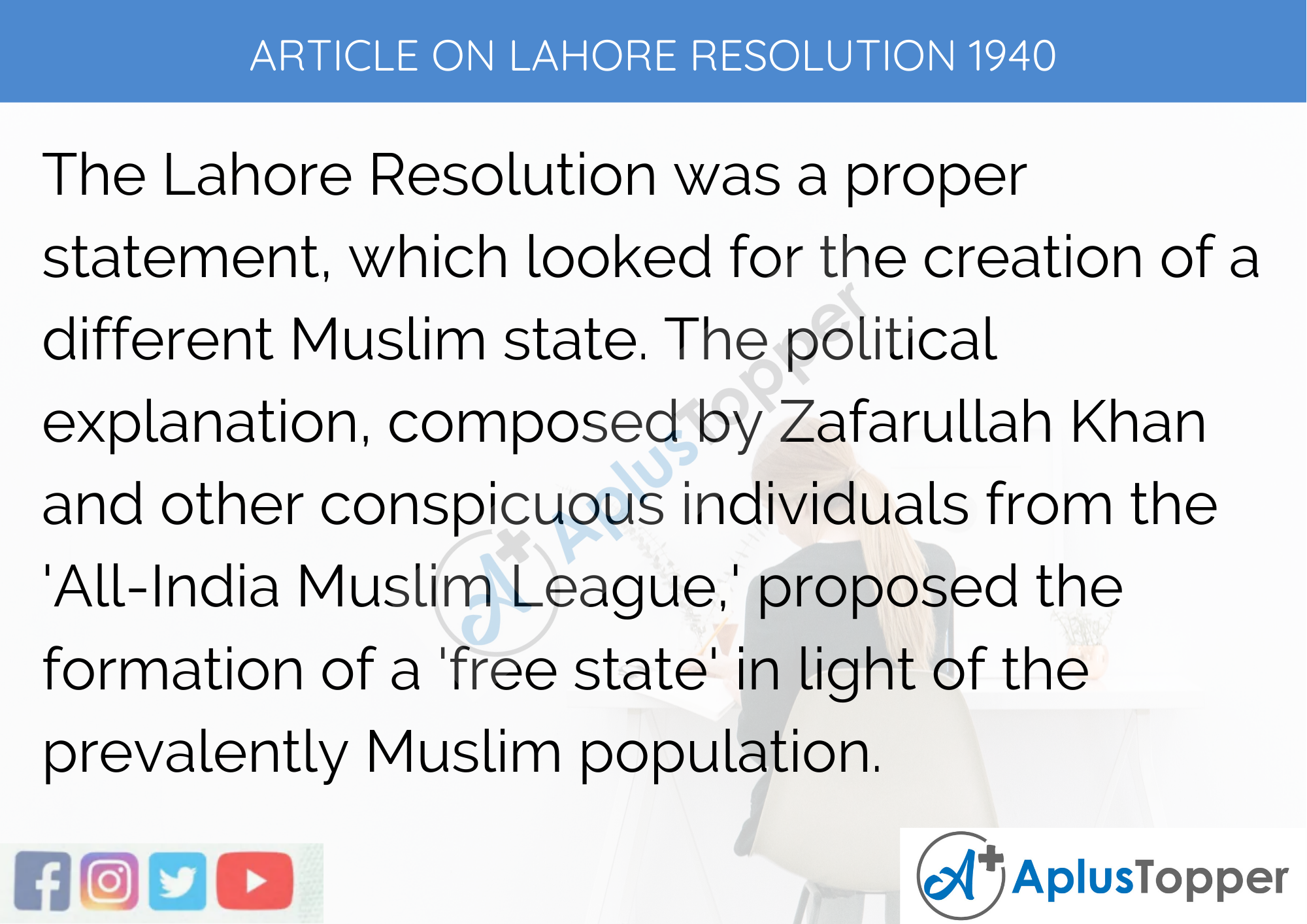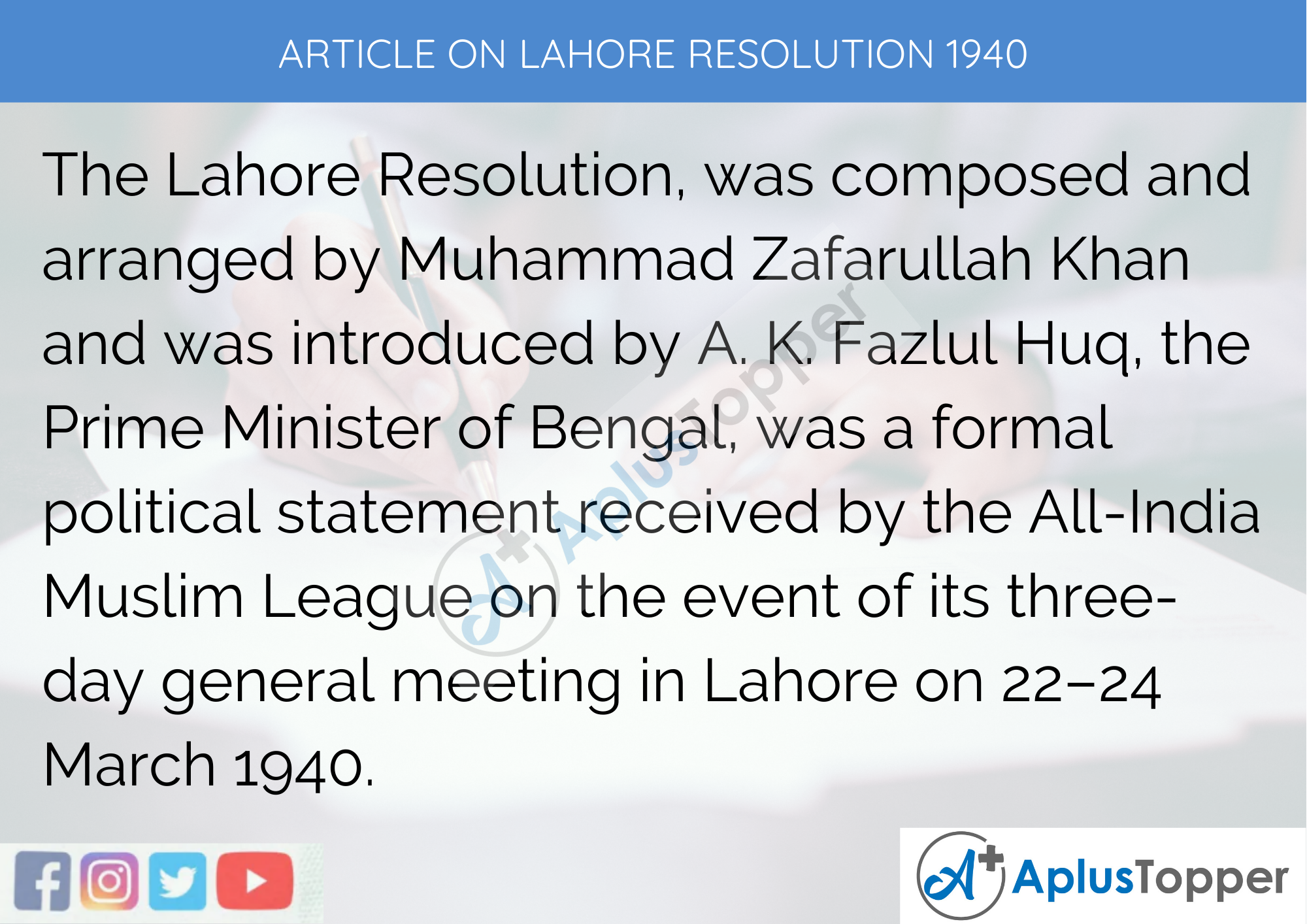Article On Lahore Resolution 1940: The creation of Pakistan has a vast history to look back. On 23rd March 1940, the Lahore resolution or the Pakistan Resolution came into account, supported and passed on 24th March 1940. The resolution was first moved by the Bengal Chief minister Maulvi Fazal-ul-Haq also known as “Sher-e-Bengal” and supported by other prominent Muslim leaders.
The main idea of Pakistan being the different state for Muslims was first explained by Mohammad Ali Jinnah, who was also the prominent leader of the Muslim League in India. He explained the consequences of a different state, how it will benefit the Muslims, and how Congress’s non-cooperation is leading them to take steps for the partition of India to get their freedom.
You can read more Article Writing about people, sports, technology many more.
Long And Short Articles On Lahore Resolution 1940 for Students and Children in English
Lahore Resolution 1940 is an essential part of the history of the Partition of India, which should be known by every Indian citizen. Students who go to schools and colleges can get asked to write articles on the subject for their assignments and exams. The long Article on Lahore Resolution 1940 are useful to people studying in classes 7, 8, 9, and 10. On the other hand, the short Article on Lahore Resolution 1940 are standard among students of classes 1, 2, 3, 4, 5, and 6.

Long Article On Lahore Resolution 1940 500 Words In English
The Lahore Resolution was a proper statement, which looked for the creation of a different Muslim state. The political explanation, composed by Zafarullah Khan and other conspicuous individuals from the ‘All-India Muslim League,’ proposed the formation of a ‘free state’ in light of the prevalently Muslim population. When the resolution was advanced by the then Chief Minister of unified Bengal, A. K. Fazl ul Huq, individuals, began using the word ‘Pakistan’ as often as possible.
On January 28, 1933, Chaudhary Rahmat Ali, a Punjabi Muslim nationalist, thought of a plan named ‘Pakistan Declaration,’ which was introduced in the 1933 ‘Round Table gathering,’ composed by the British government. The ‘Pakistan Declaration’ expressed that the Muslims living in the Northern conditions of India, specifically North-West Frontier Province, Punjab, Sind, Kashmir, and Baluchistan, would need to make a different state. However, the proposition wasn’t paid attention to by the British organization until the ‘All-India Muslim League’ decided to do something about it.
The Lahore Resolution, generally known as the Pakistan Resolution, was a formal political proclamation embraced by the Muslim League at the event of its three-day general meeting on 22-24 March 1940 that called for more prominent Muslim self-dominant state in British India. Pakistan was considered as the name of the Muslim state to be demanded. The goal was introduced by A. K. Fazlul Huq.
From March 22 to March 24, 1940, the All India Muslim League held its yearly meeting at Minto Park, which is now known as Iqbal Park in Lahore.
Muhammad Ali Jinnah clarified how Hindus and Muslims couldn’t exist together, calmly in his speech. He said that the contrasts among Muslims and the Hindus were different to such an extent that shaping a single government to oversee both the orders under one law could cause genuine problems. He further said that Muslims and the Hindus have a place with two divergent human interests, because of clashing thoughts. Jinnah accepted that Hindus and the Muslims have a place with two unique countries as the two gatherings had various events and diverse histories to get ideas from.
In his speech, Jinnah described the contemporary circumstance between the Hindu and Muslims, which can later lead to a global problem. He scrutinized the Congress and the nationalist Muslims and embraced the Two-Nation Theory and the purposes behind the interest for different Muslim countries.
During the ‘Second World War,’ the ‘All-India Muslim League’ began gathering support from South Asian Muslims, and their ‘two-country theory’ started getting energy.
Alluding to the Lahore goal, President of the Constituent Assembly, Dr. Rajendra Prasad, expressed that neither Hindus nor the Congress wanted partition. However, Muhammad Ali Jinnah and the ‘Muslim League’ were clear in their interest to make a different state for the Muslims.
Making a different state for the Muslims, in the long run, turned into an integral part of the All-India Muslim League’s political journey in India.
After the partition of India in 1947, the ‘Lahore Resolution’ was credited for having played a significant role.
Short Article On Lahore Resolution 1940 300 Words in English
The Lahore Resolution, was composed and arranged by Muhammad Zafarullah Khan and was introduced by A. K. Fazlul Huq, the Prime Minister of Bengal, was a formal political statement received by the All-India Muslim League on the event of its three-day general meeting in Lahore on 22–24 March 1940.
Even though Choudhary Rahmat Ali had proposed the name “Pakistan” in his Pakistan Declaration, it was not until after the goal that it started to be broadly utilized.
During Congress rule from 1937–39, they increased activity of Hindu Mahasabha, the lifting of Congress tricolor, the singing of Vande Mataram, the Vidya Mandir scheme in the Central Provinces and the Wardha plan of training, all were deciphered as evidence of ‘Congress atrocities.’ In this way, Congress was incapable of speaking about Muslim interests. Yet, it was attempting to demolish each other gathering, which prompted the conclusion of the Muslim leaders’ different state goals.
The meeting was held at Iqbal Park, Lahore. The welcome address was made by Sir Shah Nawaz Khan of Mamdot, as the executive of the local gathering committee. The different draft messages for the last goal/draft were thought over by the Special Working Committee of the All India Muslim League.
The resolution text, consistently endorsed by the Subject Committee, acknowledged the idea of a united country for Muslims and suggested creating a free Muslim state.
- K. Fazlul Huq introduced the historical resolution of Lahore in 1940.
The goal was moved to the general meeting by A. K. Fazlul Huq, the chief minister of unified Bengal, was supported by different Muslim leaders of different provinces.
Mohammad Ali Jinnah continuously glorified the idea of a separate Muslim state for themselves and explained the difference between Hindu and Muslim mentalities.
Lahore Resolution considered a significant reason for the partitions of India.

10 Lines On Lahore Resolution 1940
- The Lahore resolution was an old part of history for the Muslims, which created their independent country.
- On 23rd March, in 1940, the Lahore session was announced.
- It was for the cause of the partition of India arranged by the Muslim league.
- Muslims demanded equal rights, democracy, and freedom for themselves.
- They explained the differences between the mental differences of views between Hindu and Muslims.
- They Explained about future disturbances if the new state is not created.
- Indian National Congress was never in support of the partition of India.
- The failure of meeting the demands of congress led to this situation.
- After the partition, Lahore resolution considered a significant day.
- People of Pakistan celebrate that day as a national holiday.
FAQ’s on Article on Lahore Resolution 1940
Question 1.
Who passed the resolution of Lahore?
Answer:
Fazlul Huq passed the Lahore Resolution.
Question 2.
Whose demand was said to be as first demanding Pakistan?
Answer:
Mohammad Ali Jinnah demanded Pakistan for the first time.
Question 3.
When was the name of the country first coined?
Answer:
In 1933, the name of the country was first coined as Pakistan.
Question 4.
Who coined the term Pakistan for the first time?
Answer:
Choudhary Rahmat Ali, who was a Pakistan Movement activist, first coined the term Pakistan.
